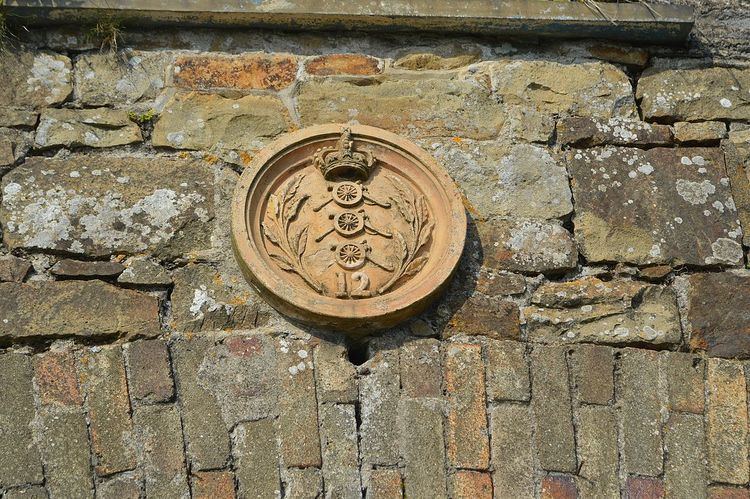Active 1859–1956 Branch Territorial Army | Country United Kingdom Type Artillery Regiment | |
 | ||
Role Garrison Artillery
Coastal Artillery | ||
The 1st Cornwall (Duke of Cornwall's) Artillery Volunteers were formed in 1860 as a response to a French invasion threat. They served as a Coast Artillery unit and continued in existence until the dissolution of Coast Artillery in the UK in 1956.
Contents
Artillery Volunteers 1859-1908
The Volunteer Force came into existence in 1859 as a result of an invasion scare and the consequent enthusiasm for joining local Rifle, Artillery and Engineer Volunteer Corps. By 24 May 1860 there were enough Artillery Volunteer Corps (AVCs) in Cornwall to form an Administrative Brigade with its Headquarters (HQ) at Bodmin to include all the AVCs in the County. From July 1861 he 1st Admin Brigade of Cornwall Artillery Volunteers appeared in the Army List under the title of The Duke of Cornwall's Artillery Volunteers with the following composition:
In May 1880 the Corps were consolidated as the 1st Cornwall (Duke of Cornwall's) Artillery Volunteers, with ten batteries distributed as follows:
In 1888 Headquarters were moved to Falmouth. In 1902 the unit was attached to the Royal Garrison Artillery (RGA) and retitled the 1st Cornwall Royal Garrison Artillery (Volunteers).
Territorial Force 1908-1920
In 1908 on the formation of the Territorial Force the corps became the Cornwall (Duke of Cornwall's) RGA.
On the outbreak of the First World War, the Cornwall RGA deployed to their war stations guarding the major ports of Cornwall under No 1 Coastal Fire Command.
Interwar years
After the war, the unit was retitled the Cornwall Coast Brigade RGA (TF) in the reformed Territorial Army, becoming the Cornwall Heavy Brigade RA (TA) in 1924 when the RGA merged with the rest of the Royal Artillery (RA).
In 1932 its Headquarters were disbanded and a battery amalgamated with the Devonshire Heavy Brigade RA (TA) to form the Devonshire and Cornwall Heavy Brigade RA (TA).
(RA Brigades were redesignated Regiments in 1938, allowing AA Groups to adopt the more usual formation title of Brigades.)
Second World War
In July 1940 the Regiment regained its independence as 523 (Cornwall) Coast Regiment, RA (TA), stationed at Falmouth.
Postwar
In 1946 the unit was placed in suspended animation, but the following year reformed in the postwar Territorial Army as 409 Coast Regiment RA (Cornwall) (TA) with Headquarters at Falmouth. It was part of 102 Coast Brigade, within Southern Command.
With the disbandment of Coast Artillery in the UK in 1956 the unit was converted to Royal Engineers as 409th (Cornwall) Independent Field Squadron, RE, and in 1961 it was included in a new 116 (Devon and Cornwall) Engineer Regiment, RE. The regiment was disbanded in 1967 when the TA was reduced and converted into the TAVR.
Uniform
The original dress of the 3rd Cornwall AVC at Fowey was a long knitted blue fisherman's jersey with the collar cuffs and bottom edge braided in red. Embroidered on the front in red wool was a device 'C.V.A.' over the figure 3, above an inverted triangle of 15 roundels (from the top 5–4–3–2–1) over a scroll embroidered 'ONE AND ALL'. The inverted triangle (or 'pile') of roundels (or 'bezants') derived from the coat of arms of the Duchy of Cornwall. It was designed by the Lord Lieutenant of Cornwall and was worn by all ranks of the 3rd AVC 1860–61.
By 1872 the uniform of all the Corps consisted of a blue tunic of Royal Artillery pattern with black cord trimmings, blue cloth trousers with red stripes, a black leather waistbelt on which was fixed the pouch, worn on the right hip. On the shoulder straps of the tunic the number of the battery was embroidered in red figures. White cotton gloves were also worn. There was no full dress uniform, and this pattern was worn by both officers and other ranks.
